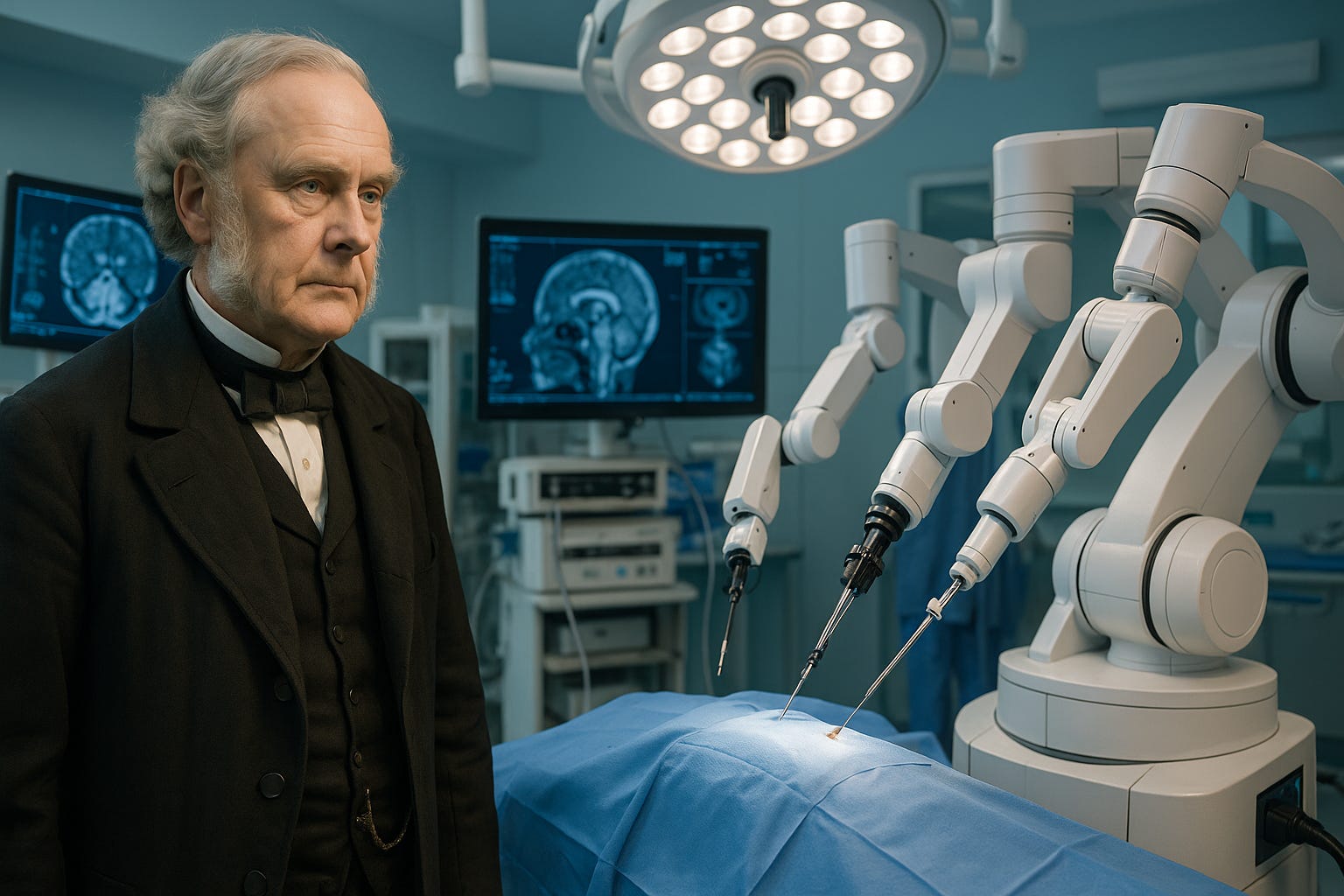Joseph Lister: Antiseptic Pioneer in the Age of Superbugs and AI Surgery
Description
The Cogitating Ceviché
Presents
Joseph Lister: Antiseptic Pioneer in the Age of Superbugs and AI Surgery
Past Forward: Historical Icons in the Digital Frontier #66
By Conrad Hannon
Narration by Amazon Polly
Preface
Joseph Lister revolutionized medicine in the 19th century by introducing antiseptic techniques that dramatically reduced surgical infections and mortality rates. Born in 1827 to a Quaker family in Essex, England, Lister brought scientific rigor to surgical practice at a time when post-operative infections claimed more lives than the original injuries or diseases being treated. His meticulous approach to cleanliness, inspired by Louis Pasteur's germ theory, transformed surgery from a desperate last resort into a reliable therapeutic intervention.
Known as the father of modern antiseptic surgery, Lister's principles underpin contemporary medical practices worldwide. His insistence on carbolic acid disinfection, sterile instruments, and clean surgical environments reduced surgical mortality rates from over 50% to less than 15% in his own practice. More importantly, his systematic approach to infection prevention established the foundation for all modern hospital safety protocols.
Lister's contributions extended beyond technique to philosophy. He understood that medicine required not just skill, but scientific understanding, careful observation, and unwavering commitment to patient welfare. His willingness to face skepticism from the medical establishment while persistently advocating for evidence-based practices demonstrated the moral courage that effective medical innovation requires.
But how would Lister react upon encountering the modern hospital landscape, where automation, artificial intelligence, and microbial warfare against superbugs have reshaped patient care? How might he view the ethical dilemmas posed by advanced medical technologies that can both heal and potentially harm? This exploration imagines Lister navigating these complex, contemporary medical and ethical landscapes, bridging his historical contributions to the forefront of today's medical innovations.
Introduction
Awakening in the sterile, humming corridors of a state-of-the-art medical center, Joseph Lister experiences a profound sensory shift from the gas-lit hospitals of Victorian England. The antiseptic scents that greet him are familiar yet refined—no longer the harsh carbolic acid he once championed, but sophisticated disinfectants that eliminate pathogens without overwhelming the senses. The floors gleam with surfaces that seem to repel contamination, walls display gentle antimicrobial lighting, and the very air moves through filtration systems that would have seemed miraculous in his era.
He gazes around with astonishment at the seamless integration of cleanliness and technology. Digital monitors display real-time air quality data, pathogen counts, and infection control metrics. The precise movements of surgical robots operate within sterile fields that maintain perfect environmental conditions. The quiet efficiency of automated systems—from medication dispensing to waste disposal—reflects a level of systematic infection control that exceeds his most ambitious dreams.
The antiseptic scents and clinical ambiance reassure him, yet the precision of robotic limbs conducting delicate operations stuns him. He watches through observation windows as surgical robots perform microsurgery with movements more precise than any human hand could achieve, their instruments automatically sterilized between each tissue interaction. The integration of his fundamental principles with this advanced technology fills him with both pride and curious concern.
He observes a surgeon consulting with an AI-driven diagnostic tool, the interaction revealing a partnership between human insight and algorithmic precision. The AI analyzes thousands of similar cases in seconds, while the surgeon brings intuitive understanding of the individual patient's unique circumstances. This collaboration represents an evolution of the systematic, evidence-based approach that Lister himself pioneered.
Lister's curiosity is piqued—how did his principles of cleanliness and caution evolve into this astonishing blend of human and machine? More importantly, have the fundamental values of patient care and scientific integrity that drove his own innovations been preserved in this technological transformation?
Historical Context and Modern Connection
In the 19th century, Lister's antiseptic practices transformed surgery from a hazardous endeavor fraught with infection to a safe and structured process. His rigorous methods using carbolic acid to disinfect surgical instruments, wounds, and even the air around surgical sites represented a revolutionary departure from existing practices. Before Lister, surgeons often took pride in their blood-stained coats as symbols of their experience, never realizing these garments carried deadly pathogens from patient to patient.
His approach was systematically comprehensive. He sterilized not just instruments, but hands, surgical sites, dressings, and surrounding surfaces. He introduced the practice of cleaning wounds with antiseptic solutions and covering them with treated dressings that prevented bacterial invasion during healing. Most importantly, he documented outcomes meticulously, providing statistical evidence that his methods significantly reduced mortality rates.
Lister reflects with pride and wonder at how his fundamental emphasis on hygiene and microbial awareness has blossomed into sophisticated infection control measures that permeate every aspect of modern healthcare. He observes infection control teams that monitor hospital environments continuously, tracking pathogen populations and implementing targeted interventions with precision that far exceeds what he could achieve with carbolic acid alone.
Yet he also recognizes familiar challenges. The hospitals he visits still battle resistant bacteria—superbugs like MRSA, C. difficile, and multidrug-resistant tuberculosis that have evolved defenses against the very antimicrobial agents designed to eliminate them. The principle remains the same as in his era: microorganisms adapt and survive, requiring constant vigilance and evolving countermeasures.
His foresight and careful observation have paved the way for a modern medical landscape that continually strives to stay ahead of microbial threats. Hand hygiene protocols, environmental disinfection standards, and surgical site preparation techniques all bear the hallmarks of his systematic approach, even as they employ technologies he could never have imagined.
Exploring Modern Innovations
Lister eagerly dives into exploring robotic-assisted surgeries and AI-driven diagnostics, drawn by their potential to eliminate many sources of human error that plagued surgery in his era. In state-of-the-art operating theaters, he marvels at robots like the da Vinci Surgical System performing minimally invasive surgeries with sub-millimeter precision. The robotic arms move with fluid grace, their instruments capable of rotating and flexing in ways that exceed the capabilities of human hands, all while maintaining perfect sterility through automated cleaning cycles.
Surgeons explain how AI algorithms analyze patient data to predict optimal surgical approaches, identify potential complications before they occur, and recommend modifications to standard procedures based on individual patient characteristics. The systems process vast databases of surgical outcomes, learning from thousands of previous cases to optimize each new procedure. Recovery times that once measured in weeks now measure in days, with infection rates approaching zero in many types of surgery.
Lister himself contributes valuable insights during these observations, suggesting enhancements in robotic sterilization protocols that combine traditional antiseptic principles with modern antimicrobial technologies. He proposes modifications to instrument design that would make them even more resistant to bacterial colonization, drawing on his deep understanding of how pathogens establish themselves on surfaces.
Working with biomedical engineers, he helps design new antimicrobial coatings for surgical instruments that actively eliminate bacteria rather than simply resisting them. These coatings incorporate silver nanoparticles, copper ions, and other antimicrobial agents that create hostile environments for pathogen survival, representing a evolution of his original carbolic acid approach.
However, Lister remains cautious about the role of automation in patient care, emphasizing that human oversight remains essential. While praising technology's potential to reduce human error and improve outcomes, he insists that intuition, empathy, and clinical judgment—human qualities machines cannot replicate—must continue to guide patient care. He observes instances where algorithmic recommendations conflict with experienced clinicians' instincts, recognizing that the art of medicine cannot be fully automated.
He proposes a collaboration model that integrates AI diagnostics with enhanced antiseptic vigilance, ensuring meticulous infection control alongside technological advancement. This approach would use artificial intelligence to optimize infection prevention protocols while maintaining human oversight of their implementation and adaptation to individual patient needs.
Ethical Reflections and Societal Impact
Lister's exploration of modern medicine soon leads him into territory that would have been unimaginable in his era—the potential misuse of microbiological knowledge for harmful purposes. He encounters research on biological weapons development, the deliberate creation of
























